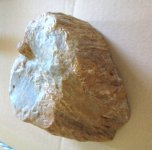turtlefoot13
Hero Member
- Aug 23, 2009
- 733
- 105
- Detector(s) used
- Teknetics Alpha 2000
- Primary Interest:
- Relic Hunting
I'm sure that this has been asked a thousand times on this forum but how is the best way to preserve a fairly rusted iron relic that is not rare or valuable? Is olive oil okay to keep it from rusting any farther? Is there any better method that will not put me in the poor house? I am finding general, iron relics like horse shoes, ox shoes, loggers pikes, axe heads, etc. and I don't want them ending up in a crumbled pile of rust. Thanks for everyone's input in advance.
Doug
Doug
Upvote
0







